Portrait of Ngadak Puntsok Rigdzin
Lo Gekhar, Mustang, Nepal mid-17th centuryNgadak Puntsok Rigdzin (1592–1656); Lo Gekhar Monastery, Mustang, Nepal; mid-17th century; papier-mâché; height approx. 35½ in. (90 cm); photograph by C. Luczanits, 2014
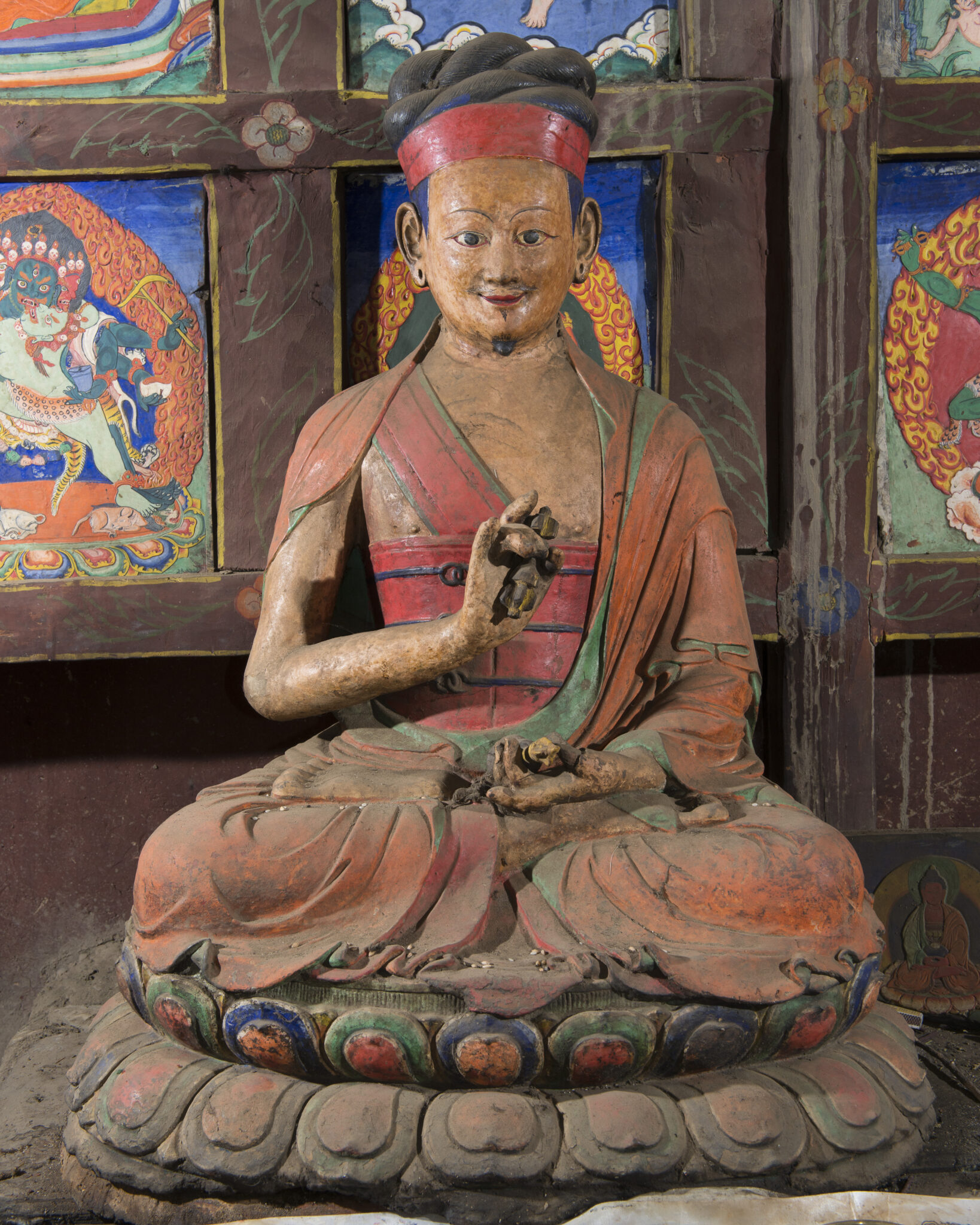
Ngadak Puntsok Rigdzin (1592–1656); Lo Gekhar Monastery, Mustang, Nepal; mid-17th century; papier-mâché; height approx. 35½ in. (90 cm); photograph by C. Luczanits, 2014
Ngadak Puntsok Rigdzin (1592–1656); Lo Gekhar Monastery, Mustang, Nepal; mid-17th century; papier-mâché; height approx. 35½ in. (90 cm); photograph by C. Luczanits, 2014
Tibet is world-famous for its metal sculptures, but statues made of clay and papier-mâché were just as common. Art historian Christian Luczanits introduces the papier-mâché statues of Lo Gekhar monastery in Mustang, and the visual convention representing seventeenth-century master Ngadak Puntsok Rigdzin whose image is found there. While Lo Gekhar is said to have been founded in the eighth century by the great Guru Rinpoche, the statues date to the seventeenth-century spread of the Nyingma tradition
A monastery is a place where monks live, study, and perform ritual. It includes temples and other structures. Monasteries are central to Buddhism, and are also important in Bon, Hinduism, and Daoism. In Himalayan, Tibetan, and Inner Asian areas, some monasteries are enormous, wealthy, and powerful institutions, with branches of satellite monasteries forming networks across regions, often with thousands of monks, many decorated chapels, and huge holdings of land. Other monasteries, called hermitages, can be extremely simple, little more than a cave where hermits meditate. Generally, a Tibetan Buddhist monastery will have an assembly hall, several temples (Tib. lhakhang) for worship of specific deities, a protector chapel, as well as monks’ accommodations. A related institution in Newar Buddhism are the baha and bahi.
The Nyingma are a tradition of Tibetan Buddhism. The Nyingma trace their lineages back to the first introduction of Buddhism into the Himalayas in the time of the Tibetan Empire, most importantly to the legendary Indian yogin Padmasambhava. The Nyingma are known for their “treasure revealers” (Tib. terton), lamas who travel the Himalayas, revealing ritual texts, objects, and hidden lands thought to be concealed within the Tibetan landscape. The Nyingma are also famed for the Dzogchen teachings, a set of meditative practices focused on the bardo states, and the nature of the mind as pure, self-arising consciousness. Unlike other Buddhist traditions, many Nyingma practitioners are not celibate and can marry, raise families, and grant Vajrayana initiations and teachings to their children.
The Nyingma tradition of Tibetan Buddhism holds that gurus of the past like Padmasambhava concealed texts, objects, and even hidden lands (Tib. beyul) throughout the Himalayan landscape, meant for later generations to discover at the time the teachings are needed. Tantric practitioners and yogis who discover these treasures are called terton, or “treasure revealers.” Treasure revealers can also uncover “mind-treasures,” revealed to them by deities or lineage masters in dreams and visions. There are treasure-revealers in the Bon tradition as well.
Historically, Tibetan Buddhism refers to those Buddhist traditions that use Tibetan as a ritual language. It is practiced in Tibet, Mongolia, Bhutan, Ladakh, and among certain groups in Nepal, China, and Russia and has an international following. Buddhism was introduced to Tibet in two waves, first when rulers of the Tibetan Empire (seventh to ninth centuries CE), embraced the Buddhist faith as their state religion, and during the second diffusion (late tenth through thirteenth centuries), when monks and translators brought in Buddhist culture from India, Nepal, and Central Asia. As a result, the entire Buddhist canon was translated into Tibetan, and monasteries grew to become centers of intellectual, cultural, and political power. From the end of the twelfth century, Tibetans were exporting their own Buddhist traditions abroad. Tibetan Buddhism integrates Mahayana teachings with the esoteric practices of Vajrayana, and includes those developed in Tibet, such as Dzogchen, as well as indigenous Tibetan religious practices focused on local gods. Historically major traditions of Tibetan Buddhism are Nyingma, Kagyu, Sakya, and Geluk.
The Tibetan script is used to write the Tibetan language, as well as several other smaller Himalayan languages. Based on the Brahmi script used in the Gupta Empire in India, the Tibetan script was developed under the Tibetan Empire in the seventh century and is credited to minister Tonmi Sambhota (b. 619?). Two important forms of the Tibetan script are “Uchen” (Tib. “having a head”), a standard type used in printed texts, and “Umey” (Tib. “headless”), a cursive form sometimes used in manuscripts. There are many other cursive and decorative forms of the script.
This life-size portrait depicts Ngadak Puntsok Rigdzin (1592–1656), a tradition master of the Ngadak family from western Tibet (fig. 1). This teacher is best known for being one of the four yogins who opened the hidden land of to . The notion of a “” surrounded by mountains signifies an ideal ground for Buddhist practice, and Sikkim is described as such in Nyingma . Meeting there, the four yogins enthroned its first Buddhist ruler in 1642. In 1651 Puntsok Rigdzin visited Lowo (Mustang) at the invitation of the royal couple Aham Samdrub Rabten and his Ladakhi wife Ayum Nyida Gyelmo, where this image has been preserved at Lo Gekhar Monastery.
The identity of the depicted is clarified by an inscribed metal sculpture of the same yogin. That the portrayed is the same teacher can be concluded from his distinctive hairstyle and unusual dress, especially the lower robe wrapped around the lower body and supported by three parallel strings. The inscription on the bronze reads:
Worship to the teacher!
This image of Todrengtsel source of all virtues [Puntskg],
auspicious emanation of the Shakya clan [Rig-] and the Tibetan ruler,
and upholder [-dzin] of the profound treasure teachings
was made to generate faith and the nine desirables.
Having completed the aspiration of the glorious teacher,
may I along with my court be endowed with a long life free of disease,
authority, prosperity, perfection, and the holy .
May this wish be fulfilled and protected in this life and in future.
Made by Agon, born of the Ama clan, and his noble spouse Nyida.
This metal sculpture, thus, must have been produced shortly after the visit of Ngadak Puntsok Rigdzin to Mustang, the vase in the teacher’s hand symbolizing the wish for his long life. The papier-mâché portrait very likely also stems from about the same time. Considering the background of the portrayed master, the emphasis on the preservation of secular power and health in the inscription is less surprising.
These portraits offer a fascinating glimpse into the mid-seventeenth century, when the Nyingma tradition appears to have mushroomed along the southern border of the Himalayas. This is in part associated with the political instability in central Tibet at the time. Ngadak Puntsok Rigdzin himself founded Tashiding Monastery in Sikkim, and the in which his sculpture is found, Lo Gekhar, must have seen a major restoration at that time.
The temple of Lo Gekhar, also known as Gar Gonpa (fig. 2), is considered the oldest Buddhist temple of Mustang and is contemporaneous with the first monastery of Tibet, Samye, which was founded in the late eighth century. The connection of these two monuments is recorded in the Pema Katang, a text containing the biography of Padmasambhava, the teacher credited with the taming of local deities across the Himalayas. This text was discovered by the treasure revealer Orgyen Lingpa (b. 1323), his date thus providing a terminus ante quem for the existence of Lo Gekhar. The relevant account is found in canto 62, recording the completion of , and is translated as follows (with explanatory additions in square brackets):
“At Lowo [Mustang], the place which is as if a rakshasi [a demoness] were lying on her back, place on her heart a monastery with nine floors, a on her navel, another small and black one on her head, and one hundred and eight on her four limbs!
In Meldro is the king called Shines in Meldro. He has great influence in Tibet; I will establish for him a naga treasure; I want his life philtre [life water].”
And the Guru came along into Meldro. Keeping his promise, shaking the depths, giving solid explanations, and having given treasure and a place of worship for the nagas, he received the life philtre. However, no oath bound the mind of the nagas, so to keep them silent, he erected at Lobo the monastery of White Virtue.

Accordingly, Lo Gekhar is this monastery of White Virtue, and the surrounding chorten and springs—referred to by the reference to the naga king, a serpent spirit associated with water—are part of the holy site. This account also explains why Lo Gekhar is of great cultural and religious importance to the Mustang region and to at large. Apart from its thick-walled core, the temple as it stands today is, of course, much more recent. The high-quality papier-mâché sculptures found at the site, the portrait of Ngadak Puntsok Rigdzin being one of them, indicate renewed attention to this monastery in the mid-seventeenth century.
Tibetan art is well known for its excellent metal , the portrait of Lowo Khenchen being a good example for an earlier sculpture of the same region. But at least half of the sculptural production preserved in the region today uses other materials, among them clay and different varieties of papier-mâché being the most prominent. No matching exhibition found for ’45’ was used extensively in early Tibetan art for the main sculptures of monuments and has been researched to some extent, but papier-mâché has not yet received similar attention. The designation of the material itself is an issue, as the term “papier-mâché” is used here for a wide variety of similar fibrous materials that enable lightweight, hollow, three-dimensional sculptures, the best of which are remarkable for their fine modeling.
The sanctum of Lo Gekhar predominantly features clay and papier-mâché sculptures, among them a set of the (fig. 3) likely made under the same master artist responsible for the portrait of Ngadak Puntsok Rigdzin. Although partially cleaned, repaired, and repainted, these images share the same attention to detail resulting in an unusual degree of realism.
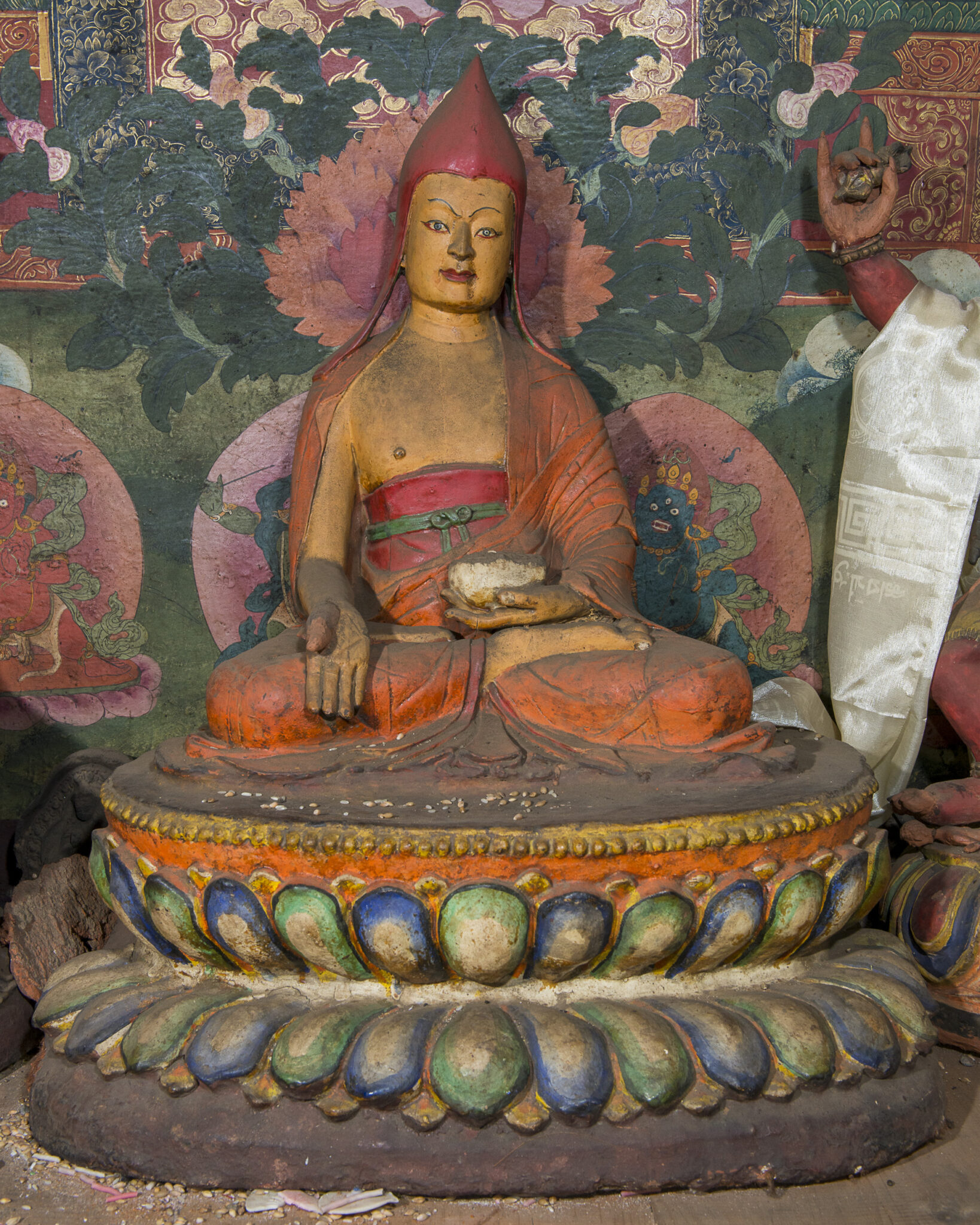
Guru Padmasambha, the scholar manifestations of Padmasambhava; Lo Gekhar Monastery, Mustang, Nepal; mid-17th century; papier-mâché; 26¾ × 22-7/8 × 15¾ in. (68 × 58 × 40 cm); photograph by C. Luczanits, 2014
From the documentation of monastery collections throughout Mustang undertaken since 2012, we can now say that all major periods of sculptural production in the region also preserve excellent sculpture in papier-mâché, although of different technologies. Fifteenth- to sixteenth-century metal sculpture is accompanied by an equally refined school of papier-mâché sculpture of different sizes, Namgyal Monastery alone preserving parts of several sculpture sets (fig. 4). Further, accomplished sculpture in this material is also found beyond the seventeenth century; a triad of Padmasambhava in the palace of Ghami is a particular compelling example preserved in the shrine made for it (fig. 5).
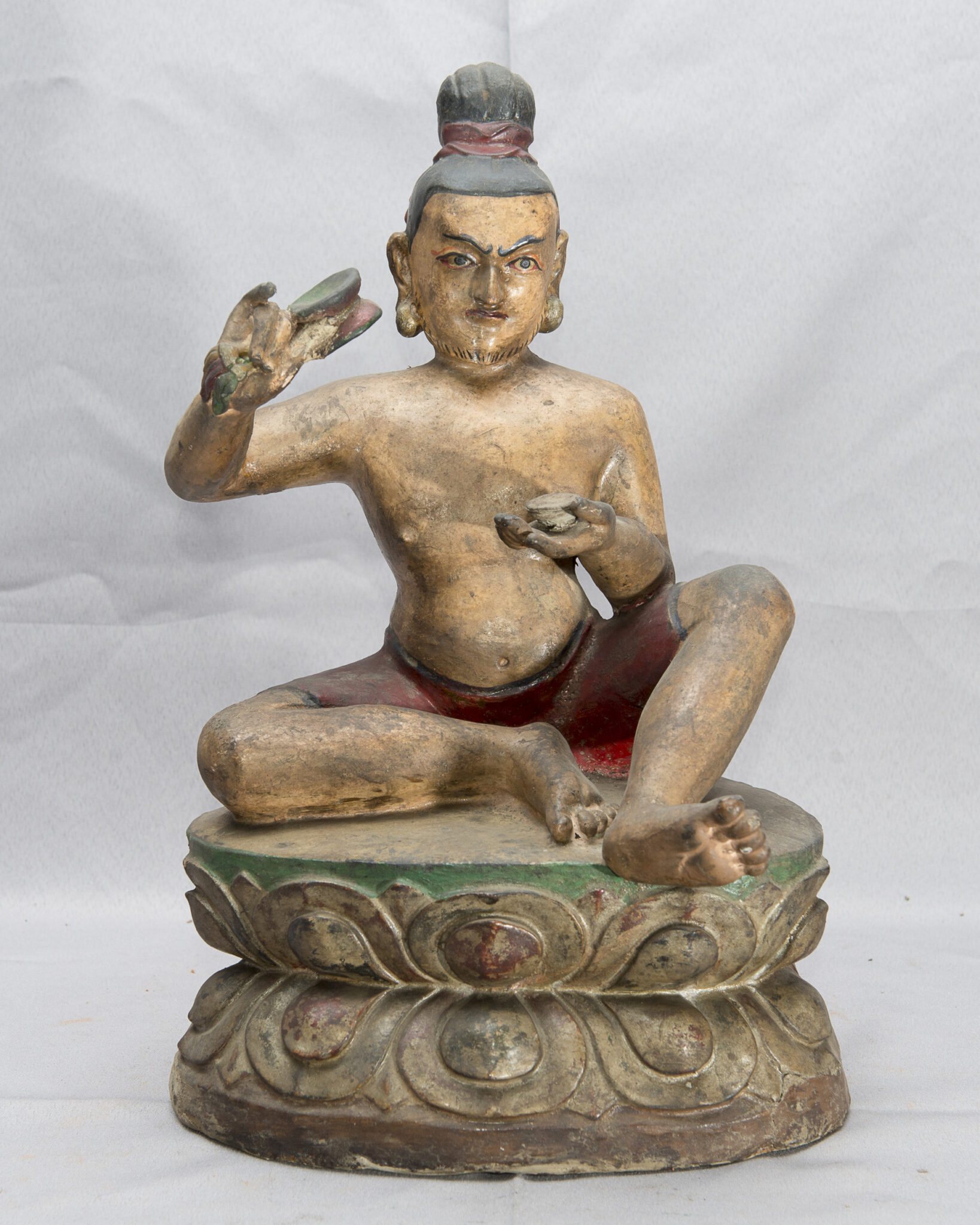
Mahasiddha Damarupa of a Lamdre lineage; Namgyal Monastery, Mustang, Nepal; 16th century; 13 3/8 × 9½ × 5 7/8 in. (34 × 24 × 15 cm); photograph by C. Luczanits, 2013
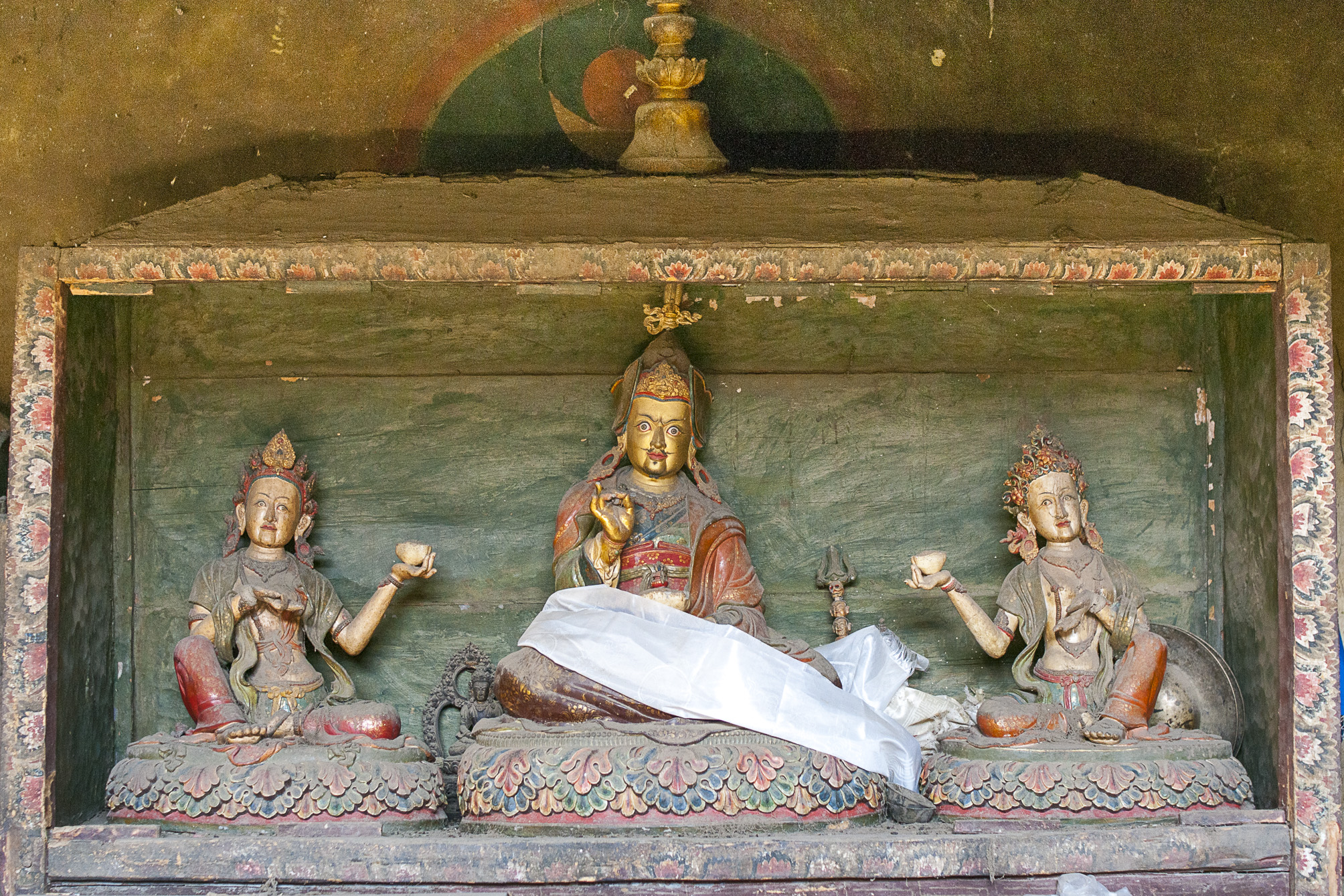
Padmasambhava Triad in Custom-Made Shrine; Ghami Palace, Mustang, Nepal; 18th century; papier-mâché; width of shrine ca. 59 in. (150 cm); photograph by C. Luczanits, 2012
The life of Ngadak Puntsok Rigdzin, leading him from western Tibet to Sikkim, and including a short but impactful visit to Mustang, demonstrates the mobility of Nyingma protagonists and the decentralized character of this tradition before it established itself at the very heart of political power in Tibet through the support of the Fifth Ngawang Lobzang Gyatso (1617–1682). Not only did the Fifth Dalai Lama reveal treasures himself, which he transmitted to the Nyingma master Terdak Lingpa (1646–1714), but he also supported the latter in establishing (fig. 6).
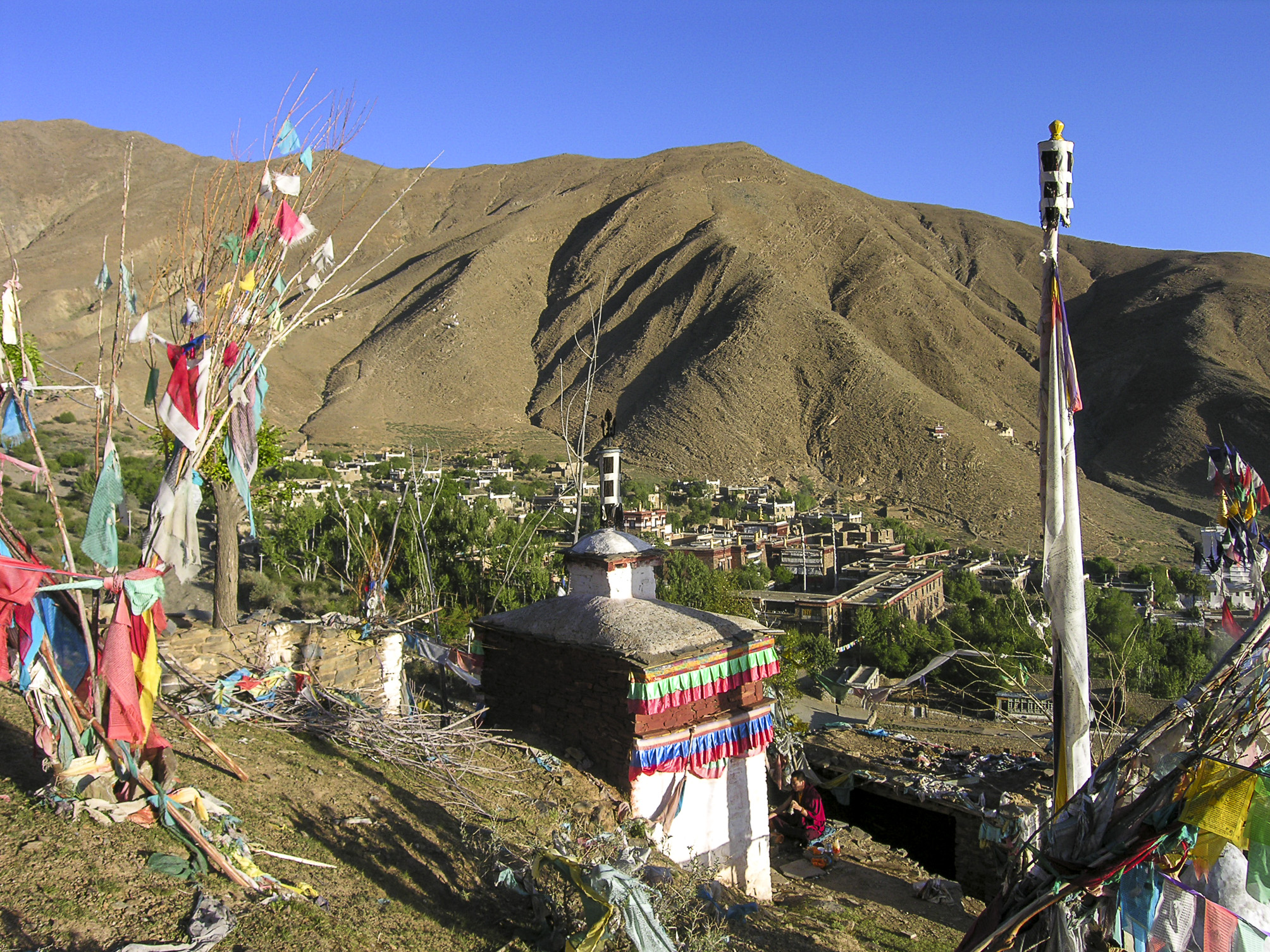
View of Mindroling Monastery; Drapchi, Dranang County, central Tibet; founded in 1676; photograph by C. Luczanits, 2007
This development in central Tibet, too, directly reflects back on peripheral regions such as Mustang, where the monasteries of Kutsab Ternga and Gonpa Gang were established by Orgyen Pelzang (1617–1677) and his disciple and successor Kunzang Longyang (1644–1696) respectively. Like Ngadak Puntsok Rigdzin, these teachers traveled widely and received teachings from numerous scholars and traditions, until establishing monasteries themselves under the support of local elites, in this case the rulers of Lower Mustang, a pattern that may be considered typical of the time.
The documentation of this image and research on it are results of an AHRC-funded research project, “Tibetan Buddhist Monastery Collections Today” (Grant Ref: AH/N00681X/1).
See the most detailed account on his life in Franz-Karl Ehrhard, “The MNga’ Bdag Family and the Tradition of Rig ’dzin Zhig Po Gling Pa (1524–1583) in Sikkim,” Bulletin of Tibetology 41, no. 2 (2005): 11–29.
The reproduction of the sculpture previously published in 2010 and the information about the village it is located in have been removed on behalf of the anonymous owner mediated by Amy Heller.
The image has been published in Amy Heller, “Portable Buddhist Sculptures of Lo: A Chronological Selection, 15th through 17th Centuries,” in Wonders of Lo: The Artistic Heritage of Mustang, ed. Erberto Lo Bue (Mumbai: Marg Foundation, 2010), 90–105, figs. 7.9a, 7.9b, its inscription transcribed in n. 14. She identifies the teacher based on a mention in the Tsarang Molla (Jackson 1984, 150, 155), without attempting to explore his background. Heller’s reading has been amended on the bases of photographs on the Mustang DVD of Lionel Fournier. The Sanskrit text ending the inscription is not documented on these photographs and thus is not being reproduced here: na mo gu ru/ phun tshogs dge legs kun ’byung thod phreng bstsal// skal ldan don du shag rigs bod rjer sprul// zab gter dam chos srid ’dzin gang de’i sku// dad ldan ’dod dgu ’byung ba ’di zhengs pas// dpal ldan bla ma’i thugs gongs rdzogs pa dang// bdag swogs ’khor bcas tshe ring nad med cing // mnga’ thang dpal ’byor phan chogs dam chos ldan// bsam don ’grub cing ’di phyi kun du skyobs// A ma’i rigs skyes A mgon dang lha lcam nyi zla’i zhengs// In the translation, Todrengtsel, a common secret name of Padmasambhava, is taken as referring to the depicted master as Padmasambhava’s successor. I am grateful to Yannick Laurent for his corrections and comments to my reading and translation.
This refers to the story of the Himalaya-size demoness that had to be pinned down by temples to make it a fertile ground of Buddhism; see Janet Gyatso, “Down with the Demoness: Reflections on a Feminine Ground in Tibet,” Tibet Journal 12, no. 4 (1987): 38–53.
Yeshe Tsogyal (Ye shes mtsho rgyal), The Life and Liberation of Padmasambhava (Padma Bka’i Thang), trans. Kenneth Douglas and Gwendolyn Bays, 2 vols. (Reprint, Berkeley: Dharma Publishing, (1978) 2007), 385, with the spellings of Tibetan names adapted to the conventions used throughout this resource.
Christian Luczanits, “Early Tibetan Clay Sculpture,” Aziatische Kunst 33, no. 2 (2003): 2–15 and Christian Luczanits, Buddhist Sculpture in Clay: Early Western Himalayan Art, Late 10th to Early 13th Centuries (Chicago: Serindia, 2004).
On the collection of Namgyal Monastery, see Christian Luczanits, “Inspired by the Past: The Art of Chöying Dorjé and Western Himalayan Sculpture,” in The Tenth Karmapa and Tibet’s Turbulent Seventeenth Century, ed. Karl Debreczeny and Gray Tuttle (Chicago: Serindia, 2016), 107–51 and Christian Luczanits, “Portable Heritage in the Himalayas: The Example of Namgyal Monastery, Mustang: Part 1, Sculpture,” Orientations 47, no. 2 (March) (2016): 120–30.
Dudjom Rinpoche Jikdrel Yeshe Dorje, The Nyingma School of Tibetan Buddhism: Its Fundamentals and History, ed. and trans. Gyurme Dorje and Matthew Kapstein, 2 vols. (Boston: Wisdom, 1991), 821–34.
See John Harrison et al., eds., A Blessing for the Land: The Architecture, Art and History of a Buddhist Nunnery in Mustang, Nepal (Kathmandu: Vajra, 2018).
Dorje, Gyurme, and Matthew Kapstein. 1991. The Nyingma School of Tibetan Buddhism: Its Fundamentals and History. Boston: Wisdom.
Ehrhard, Franz-Karl. 2005. “The mNga’ bdag Family and the Tradition of Rig ’dzin Zhig po gling pa (1524–1583) in Sikkim.” Bulletin of Tibetology 41, no. 2, 11–29.
Harrison, John, Christian Luczanits, Charles Ramble, and Nyima Drandul, eds. 2018. A Blessing for the Land: The Architecture, Art and History of a Buddhist Nunnery in Mustang, Nepal. Kathmandu: Vajra.
Christian Luczanits, “Portrait of Ngadak Puntsok Rigdzin: Papier-Mâché Sculpture and the Nyingma School at the Periphery,” Project Himalayan Art, Rubin Museum of Art, 2023, http://rubinmuseum.org/projecthimalayanart/essays/portrait-of-ngadak-puntsok-rigdzin.
Lorem ipsum dolor sit amet consectetur adipisicing elit. Cum nihil placeat pariatur deserunt eius ullam incidunt maxime sunt ipsam. Ipsa, provident, laudantium, rem assumenda laboriosam veniam autem voluptas sint officia distinctio enim aut explicabo fuga animi voluptatum earum recusandae excepturi atque dignissimos iste? Exercitationem, praesentium eum. Harum ut maiores expedita exercitationem perspiciatis soluta aperiam dolores natus unde, sequi vitae debitis ex aliquam quas eum reprehenderit esse. Cumque amet et earum necessitatibus, repellendus ullam ducimus corporis architecto culpa placeat eum odit cum iure illo vitae rerum! Ullam et suscipit culpa? Eos voluptatum laudantium iste vero impedit adipisci maxime magni natus voluptatibus.
Get the latest news and stories from the Rubin, plus occasional information on how to support our work.